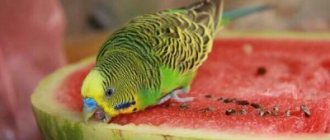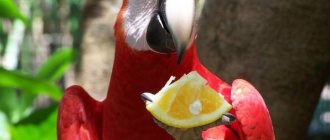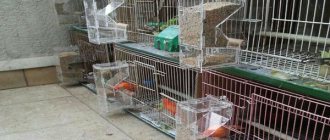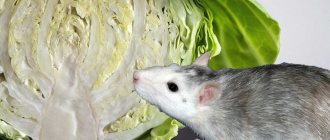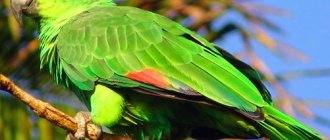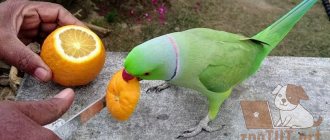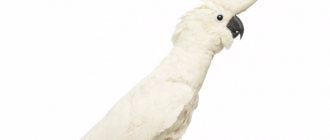Could a budgie eat food without a beak? Answer: no! And breathe, make a nest, clean feathers, defend yourself, climb the cage bars. No again! The beak is very important for the bird. All diseases that affect this part of the body bring a lot of discomfort to feathered pets. Therefore, it is vital to constantly monitor the health of your winged friend's beak. This article is written to help you understand the difficulties you may encounter and how to take the necessary treatments in time. You will also learn what kind of beak should be, what to do if a budgerigar has a long beak, it is peeling, or a growth has formed near it.
Be prepared for the fact that the article shows photographs of diseases that make the appearance of our beloved pets unattractive!
Congenital diseases
It happens that a bird is born with a similar problem. Unfortunately, in most cases it is impossible to correct the situation in such a situation. You can help the chick only by assisting it during feeding. You need to feed every three hours. Over time, the bird will learn to drink and peck food on its own. An adult budgie with congenital beak disease has the following sad characteristics:
- breathing heavily
- rarely flies
- cannot repeat sounds correctly
- The beak opens and closes incorrectly.
The good news is that despite his serious illness, he will be able to live with your help.
Lifespan
The average lifespan of domestic budgerigars is 8-10 years. In favorable conditions and with proper care, they can live 12-15 years. There are often long-livers whose age has reached 20 years or more.
The lifespan of birds is positively influenced by the following factors:
- nutritious, balanced diet;
- regular feeding with mineral mixtures;
- quality drinking water;
- maintaining hygiene;
- a spacious, clean cage in a warm room that is periodically ventilated;
- proper lighting;
- systematic walks (it is advisable for the parrot to fly out of the cage every day);
- regular examination and timely treatment;
- frequent contact with the pet and friendly communication.
Parrots are sensitive and vulnerable birds. They pick up on a person’s negative emotions and have a hard time withstanding aggression and shouting. Stress can cause them illness and even death. Therefore, it is very important to show them kindness and care. In a friendly environment, parrots are active and sociable. They easily make contact, quickly learn to speak and willingly reproduce when there is a pair.
In the wild, budgerigars live 3-5 years. They often die from lack of food or become prey to predators. It is thanks to the creation of favorable conditions that domestic birds live much longer than their wild counterparts.
Knemidocoptosis
Otherwise, this disease is called scabies . It occurs due to parasitic scabies mites on the body of the parrot. As a result, the pet's skin itches. It happens that this disease leads to problems with the beak of budgerigars; it becomes deformed.
If an infection is detected, do not waste time, immediately go to a veterinary clinic to see a specialist!
Sprawl
The growth of horny plates is affected, first of all, by the lack of hard material. In nature, parrots move freely, tugging at twigs and sorting through stones. They walk along tree rhizomes and climb trunks. The beak and claws wear down naturally. At home, birds are deprived of this opportunity. Smooth cage bars and plastic perches do not contribute to beak shortening.
Other reasons for the rapid regrowth of plates:
- excess macronutrients;
- slow metabolism;
- abundance of fats in the feed;
- infections;
- diseases of internal organs;
- hormonal disbalance.
Due to increased growth of the beak, feeding problems may arise: the long part will interfere with taking food. The bird won't even be able to scratch itself normally. Of course, the pet will try to adapt to the current situation, but it will lose its usual comfort.
The owner should contact a veterinarian. You can try to trim the keratoid plate yourself, just so that the parrot’s beak does not crack. The manipulation is carried out with a nail clipper, having previously marked the place of shortening.
Attention! A sharp instrument must be handled carefully so as not to touch blood vessels. If blood does flow, it is stopped with a solution of hydrogen peroxide.
Beak softening
Causes:
- unbalanced diet,
- fungal, viral or bacterial disease.
If softening of a budgerigar's beak occurs for the first reason, then it is necessary to add vitamins C, A and minerals to the food. To do this, purchase a special multivitamin complex at the pet store and add it to the bird’s diet according to the attached instructions. When sick, use only soft food. Otherwise, the beak will be like an accordion.
If the beak has softened for the second reason, then only a veterinarian can help. They will be prescribed the necessary medications. It should be noted that viruses, fungi and bacteria can not only cause a softened beak, but also the formation of a growth on it.
Signs of an older bird
If a parrot at the age of 8-10 months can be easily confused with an individual that is already 3-5 years old, then you can recognize an old bird.
Signs of an elderly bird:
- over the years, the plumage around the eyes disappears;
- the pupil is cloudy, often with a whitish spot in the middle;
- the plumage loses its rich color, becomes dull, and bald patches appear in places;
- the tail has bald spots (sometimes there are no feathers at all).
Behavior also reveals old age. “Old people” are not so active and inquisitive, they move little, they prefer to sit, occasionally flying to the next perch.
Beak delamination
Why do budgerigars’ beaks sometimes peel or flake off and what to do in such a situation? Again, the main reason for this problem is that your feathered friend’s body lacks vitamins. Pay special attention to nutrition. It must be complete and balanced. If your bird has the wrong diet, its metabolism will inevitably be disrupted. The body no longer has enough calcium. Veterinarians often advise adding sprouted wheat grains and complexes of vitamins and minerals to the main food. In addition, to prevent such beak diseases, give your budgie crushed chalk, feed yeast, and crushed shells.
Hygiene
If you periodically observe the life of a tamed pet, you will certainly notice that it does almost all its daily activities with the help of its beak. Your bird even defends itself exclusively with the help of its strong and powerful beak, which often leaves marks on your hands.
However, without proper attention on your part, misfortune can happen to your budgie. The parrot may want to taste some sharp or simply dangerous object, causing damage to its beak.
Subsequently, some unpleasant disease may develop in the damaged area, threatening the death of the pet. Among the most common injuries and ailments that your budgie can receive due to negligence are a hole in the beak, a tumor, and much more.
Therefore, before your chosen pet settles in the cage you purchased, it should be thoroughly disinfected and treated with boiling water. This is the only way you can guarantee the absence of various pathogens and parasites inside the cell.
Growth on the beak of a budgerigar
Disease factors
reasons are identified :
- hyperkeratosis;
- Knemidocoptosis.
So, we found out why a budgie may develop growths on its nose. Now let's take a closer look at these factors.
As for the second reason, as mentioned earlier, it is scabies, which occurs as a result of infestation by mites.
The first reason is again an avian disease that destroys the wax. As the disease progresses, it changes color over time to increasingly darker tones. Until it takes on a brown tint. At the same time, its size thickens. That is, the area of skin next to the nostrils on the nose of a budgerigar gradually turns black, and can darken very much, until it eventually becomes black-brown in color. It should be noted that the wax may not completely change color, but simply acquire brown spots. The skin grows in different directions. Near the nostrils, it begins to turn upward, blocking them, which entails a disruption in the respiratory processes of the budgie. A bird with this disease demonstrates its anxiety, is nervous, and itches in the hope of getting rid of the growth.
If you do not treat your pet in time, skin growth will lead to death.
The disease is often observed in females, rarely in males.
Exceptions
Varieties of budgerigars are divided into 2 large groups. Group 1 includes all types of birds with normal waviness (different colors have their own subgroups). Group 2 includes breeds of parrots that were subject to various mutations and did not retain the wavy pattern. These include the following types:
- birds with opaline color;
- pieds;
- albinos;
- lutinos;
- lacewings;
- harlequins and others.
Parrots of mutation breeds have their own characteristics, so determining their age can be more difficult. Each type has its own characteristic features, namely:
- the wavy pattern on the head is almost always absent; the “cap” adorns the head of both juveniles and adults;
- eyes remain black from birth until old age;
- Lutinos and albinos have red eyes throughout their lives;
- the beak is yellow at birth, or the black color disappears during the first 3-4 weeks of life;
- the cere changes color in the first months only in females (its colors are the same as in ordinary wavy breeds), and males at any age retain the beak pink, white or blue.
Therefore, in recessively variegated and pure parrots, age is determined by the following indicators:
- tail length;
- size of the individual;
- condition of the skin on the paws;
- density and structure of plumage.
Non-standard cases also occur among birds from group 1 with normal undulation. There are chicks that were born with an iris around the eyes or with a bright blue cere. In order not to make a mistake, it is important to consider the parrot according to all the main parameters.
Important Tips and Information
Always pay attention to the condition of your bird's beak. Compare it with a photo of a healthy beak on a budgerigar. For example, with the one I attach below.
Monitor the feeder carefully. Remove sharp sticks, pebbles, and pieces of nuts from it in a timely manner, because such things can injure the beak. Every scratch can cause an infectious disease. As a result, the budgerigar's beak will begin to delaminate, it will begin to deteriorate, and a growth may even form.
If the mucous membrane is swollen and very large, then the pet’s body does not have enough vitamin A. This is often also accompanied by the formation of small compactions (granulomas). When the mucous membranes are neglected, white and dense coatings are observed in parrots. Never give any vitamins without veterinary advice. Excess of vitamins, as well as their deficiency, can lead to serious health problems.
Don't panic prematurely. Every year there is significant progress in veterinary medicine. Therefore, most likely, it is possible to help your bird. Contact your doctor in a timely manner, then everything will be fine!
Help
Beak treatment must be carried out immediately after identifying the problem and making a diagnosis, since the inability to eat or breathe normally leads to the rapid development of other diseases, and in advanced cases, to death. The bird should not be treated on its own; You should first consult your veterinarian.
Treatment procedures depend on the final diagnosis. For parasitic, fungal and bacterial infections, appropriate medications are prescribed. If a parrot's beak is broken, it is fixed with special glue and wire. If a bird's beak has darkened, this indicates tissue necrosis; in this case, it is impossible to restore the function of the organ. If the beak looks flaky or soft, or growths have appeared on it, it is necessary to adjust the parrot's diet and introduce vitamin and mineral supplements into it. If the bird's beak shape has changed, it is trimmed accordingly; The same is done for congenital deformities and excessive growth. This must be done carefully so as not to damage the blood vessels.
For any lesions on the beak, the bird requires a special diet. If eating causes pain in your parrot, it should be fed mainly soft and liquid food. Sometimes force feeding through a syringe or tube may be necessary.
Internal
Now let's consider the internal structure of a feathered friend, because basically all vital processes take place inside, if they stopped, the bird would not be able to exist. A parrot has 46 chromosomes, just like humans.
Voice apparatus
They have an amazing vocal apparatus, thanks to which they can reproduce various sounds, including human speech.
Birds remember sounds and, with the help of a special structure of the vocal apparatus, are able to reproduce them, as well as produce beautiful singing. They have four modulators, while humans have only one.
Respiratory system
The respiratory system allowed oxygen to enter the bloodstream. Due to the high metabolic rate required for flight, birds experience an increased need for oxygen. The development of an efficient respiratory system allowed the evolution of flight. Birds ventilate their lungs using air sacs. Air sacs can account for up to one-fifth of the body's volume!
They breathe through their nostrils, which are located at the top of the upper beak. From their nostrils, air enters a series of nasal cavities, where the air is cleared of dust and particulate matter. From the nasal cavities, air then passes through the trachea to the syrinx, where the air flow is divided into two parts. Instead of going directly into the lungs, the air first enters the air sacs. It takes two inhalation/exhalation cycles for the air to completely pass through the air sacs and lungs.
The cardiovascular system
The cardiovascular system is responsible for delivering oxygen to the body's cells and also plays an important role in maintaining body temperature. The parrot's circulatory system consists of the heart plus all the vessels used to transport blood (arteries, veins, capillaries).
Like mammals, the heart has four chambers, two atria and two ventricles, which act as two separate pumps. After passing through the body, the blood is pumped under high pressure to the lungs. Upon returning from the lungs, it is pumped under high pressure into the body.
Digestive system
The feathered fellow has some unusual features that help him quickly process food. Birds have high energy demands and therefore need to digest their food very efficiently.
Birds' mouths are very different from ours, and they don't chew like we do. There are no teeth and there is no saliva in the mouth. When they eat, they use their beaks to open seeds, nuts and fruits.
The internal parts of digestion are the liver, gall bladder, intestines, pancreas, stomach and goiter.
Nervous system
The nervous system consists of the brain, spinal cord, and nerves that run throughout the body. Main functions of the nervous system:
- Coordinate body actions by transmitting signals;
- Provide sensory information about the internal and external environment;
- Store information as memory.
Excretory system
Chemical digestion of birds and absorption of nutrients occurs in the small intestine. The small intestine of birds receives bile from the liver and digestive enzymes from the pancreas, which help in this process.
The remaining materials then pass through the colon, which consists of a short colon. Finally, the gastrointestinal tract ends at the cloaca, where fecal and urinary material is collected before it is excreted through the anus.
The urinary system is the body's waste removal system. The main function of the kidneys is to process and remove waste from the blood.
Reproductive system
The genital organs of birds are not particularly developed. Males lack a penis. In order to transfer the ejaculate to the female, the male climbs on his back, the holes are compressed, since the male does not have a penis.
Once intercourse is complete, the sperm travels up the oviduct to the egg, where fertilization occurs. The fertilized egg connects to the yolk sac, both return down the oviduct to an area where a membrane forms around them, and are then expelled through the opening of the locula.
Age of a parrot by human standards
Among other species from the Parrot family, budgerigars cannot be called long-livers. There are many breeds whose representatives live for decades. But when compared with human life, wavy individuals live to a ripe old age.
The age ratio between humans and parrots is presented in the table:
| Budgerigar | Human |
| 1 month | 7 months |
| 3 months | 1 year 9 months |
| 6 months | 3 years 6 months |
| 9 months | 5 years 3 months |
| 1 year | 7 years |
| 2 years | 14 years |
| 3 years | 21 years old |
| 4 years | 28 years |
| 5 years | 35 years |
| 6 years | 42 years |
| 7 years | 49 years old |
| 8 years | 56 years old |
| 9 years | 63 years old |
| 10 years | 70 years old |
| 11 years | 77 years old |
| 12 years | 84 years old |
| 13 years | 91 years old |
| 14 years | 98 years old |
| 15 years | 105 years |
The peculiarity of budgerigars is to maintain their appearance and beauty throughout their lives. They are energetic and curious, sociable and often talkative. Pet birds can become true friends in the home.
In order for a parrot to please its owners with its company for as long as possible, it is better to acquire it at a young age. To do this, it is important to study all the distinctive characteristics. Armed with knowledge, you can safely go in search of your future pet.
Description
All representatives of various species of the Parrot family have an impressively strong beak. This is the main tool with which a bird obtains food for itself, grinds it, builds a nest, takes care of its own plumage, and even fights off in case of an enemy attack. Ornithologists believe that it is not only a tactile organ (that is, a kind of “third hand”), but also a “third leg” that helps to move along vertical surfaces, such as wood.
The beak of a parrot reminds anyone with any knowledge of zoology of the teeth of rodents. They are also constantly growing, and the animal is forced to grind them down, crushing almost everything in its path. So our bird needs to gnaw either perches, or tree branches brought by the owner, and then, if it happens, parts of the apartment interior. Otherwise, the beak will lengthen so much that the bird will not be able to feed normally.
What does an overgrown beak look like?
It is known that this organ, in its chemical composition, is formed from keratinized rough tissue, and its growth, first of all, depends on the diet provided to the bird. If there are too many minerals in grain mixtures and supplementary foods, the body part in question will lengthen faster than it should. In this case, the owner just needs to reconsider the menu of his feathered friend, perhaps place a special sharpening stone in the cage, and the problem will be solved.
However, it happens that these measures are not enough. And that's why.




